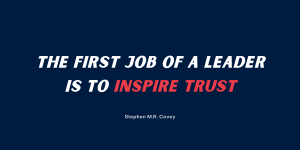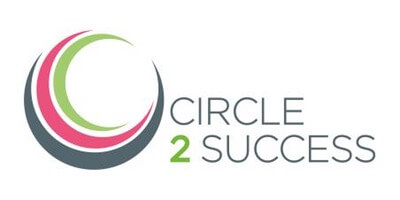
Too often, as leaders, we focus on what our team members are doing wrong. We complain about their lack of skills. We scoff at their seemingly minimal effort. We assume they aren’t cut out for the job. We start looking for ways to replace them with the next person.
Any leader needs to have team members who are making the right choices and being proactive. As I covered last week, instead of assuming all things that go wrong are your team’s fault, turn around and look at yourself in the mirror. There is a good chance that your team’s negative or lack of proactive choices is your fault. This often stems from a weak relationship caused by a lack of trust.
The second principle in Building the Best is:
Without Strong Relationships, You Can’t Lead
It Starts With Trust
The people you lead, work to provide for their families, achieve things, and do work that matters. They have to believe in, and most importantly, trust you as their leader. This trust comes from the knowledge that you are competent and that you care.
The ability to lead a team starts with good, quality, professional relationships built on the bond of mutual trust. As a leader, you must consistently share your competence, care, and character to earn trust. The keyword here is consistency. Reid Hoffman, the founder of LinkedIn and partner at Greylock, came up with my favorite formula for easily understanding trust.
Consistency + Time = Trust
When you break down the simple formula, it makes so much sense. Regardless of how long you have been leading other people, we can all relate to building trust with someone. Trust is the foundation of every relationship, personally or professionally, and just as Hoffman’s formula states; it’s built through consistency over time.
Here is the problem; today’s remote work environment makes it harder to build and maintain strong relationships. The reason being the amount of time we have available to build relationships is contracted by the speed at which business is moving.
If you find yourself leading a remote team and having the majority of your day blocked with Zoom meeting after Zoom meeting, try these trust-building techniques to help to build the bond of mutual trust with your team:
Keep a “PeopleDoc”
In our research at LearnLoft, most managers have eight direct reports. This means, at a minimum, each manager should have eight one-on-one scheduled meetings a week. These meetings not only allow leaders to help an individual perform better, but it also allows them to learn about each person and their unique situation.
These life details should be kept in what I call a “PeopleDoc.” This is a live working document for you to write down all of the information on each team member, such as:
- Work anniversary
- Birthday
- Significant other’s name, kid(s) names and ages
- Strengths and weaknesses
- Long-term career aspirations
- Hobbies and interests outside of work
While some might call the “PeopleDoc” elementary, these six details about each person just scratch the surface about what you should know about a team member. Multiply this by the total number of members on your team, and you have a lot of data to remember. Use a “PeopleDoc” to help and even remind you to write a thank you note on their work anniversary or send a gift card on the anniversary of a loved one’s death.
Reject Micromanaging, Embrace “Macromanage”
Since so many managers are still leading a remote team and will continue to for an extended period of time, it’s easy to get out of the habit of micromanaging. If you are going to build bonds of mutual trust, you have to reject even the slightest desire to micromanage and instead embrace “Macromanage.”
Adam Grant presented this idea on a LinkedIn:
View media in original article
When you take the time to notice the extra effort and the impact a person’s contribution has on the broader mission, it shows the person and the entire team you care enough to recognize it.
Reject Your Natural Instincts
One of the most popular reasons LearnLoft partners with human resource managers is to them help turn around an underperforming manager or group of managers. While in a coaching session with a particular manager who was struggling, it became evident that he had much stronger, trust-based relationships with the men on his team over the women.
As we unpacked the reasons, we found he gravitated towards the men because they looked like him, behaved like him, and had the same interests outside of work as him. The women on the team were in roles he had little to no firsthand experience. They certainly didn’t talk like him or think like him. Through multiple coaching sessions, he came to the self-realization that he had been playing favorites and putting in more effort with the men on his team over the women.
If you want better trust-filled relationships, look beyond commonalities.
What I know now from working with thousands of leaders is that this man is not an anomaly. All leaders are challenged with overcoming different biases in order to have better trust-filled relationships. However, our natural instincts are to gravitate toward and trust people who look, act, or behave like us.
No one says you have to be best friends with every member of your team to have a strong bond of mutual trust. The key is for you to knowingly reject your natural instinct and instead give everyone the time, attention, and energy they deserve.
Closing
Of course, building trust as a busy leader goes beyond these techniques. I could write for days about the importance of being present in every interaction, showing genuine care for each team member, or knowing your team’s time is as important as yours. The key here is that you can’t effectively lead without trust, and being busy isn’t an excuse.
Download the Leading Remote Teams Toolkit for free Here.
About the Author: John Eades is the CEO of LearnLoft, a leadership development company helping improve the performance of struggling managers. He was named one of LinkedIn’s Top Voices in Management & Workplace. John is also the author of Building the Best: 8 Proven Leadership Principles to Elevate Others to Success. You can follow him on Instagram @johngeades.
|
